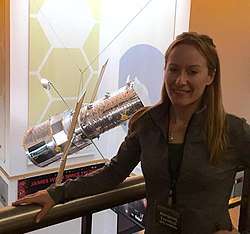Margaret Turnbull
| Margaret Turnbull | |
|---|---|
 At the Space Telescope Science Institute in 2016 | |
| Nationality | United States |
| Alma mater | University of Arizona |
| Known for | Planetary habitability |
| Scientific career | |
| Fields | Astronomy |
Margaret Carol Turnbull is an American astronomer. She received her PhD in Astronomy from the University of Arizona in 2004. Turnbull is an authority on star systems which may have habitable planets, solar twins [1] and planetary habitability. She is also an expert on the use of the coronagraph in the direct detection of exoplanets.
In 2002, Turnbull developed the HabCat along with Jill Tarter,[2] a catalog of potentially habitable stellar systems. The following year Turnbull went on to further identify 30 particularly suitable stars from the 5,000 in the HabCat list that are within 100 light years of Earth.[3]
In 2006, Turnbull drew up two shortlists of just five stars each.[4] The first formed the basis of SETI radio searches with the Allen Telescope Array (Beta Canum Venaticorum, HD 10307, HD 211415, 18 Scorpii, and 51 Pegasi). The second are her top candidates for the Terrestrial Planet Finder (Epsilon Indi, Epsilon Eridani, 40 Eridani, Alpha Centauri B, and Tau Ceti).
In 2007, Turnbull was cited as a "Genius" by CNN for her work cataloging stars most likely to develop planets that could support life and intelligent civilizations.[5]
Turnbull's work has continued to be an integral component in the search for life in the universe[6] and she regularly contributes to the discussion on how life is defined and strategies for its detection.[7] Her previous work on target selection with the HabCat list and expertise with coronagraphs have made her an important advocate for direct exoplanet imaging missions, and she served as Science Team Leader for the New Worlds Mission.[8] In 2016, Turnbull became a leader of a Science Investigation Team for the Wide Field Infrared Survey Telescope (WFIRST), which is simulating mission data and selecting targets for the direct imaging exoplanet searches. In 2017, Turnbull worked with Stephen Kane to place constraints on the mass of Proxima Centauri b, the nearest exoplanet to our solar system.[9]
The asteroid 7863 Turnbull was named in her honor.
In April 2018, Turnbull announced her plans to run for the office of Governor of Wisconsin, along with running mate Wil Losch. [10]
References
- ↑ staffwriter (1 January 2004). "Gem Sorting for the Next Earth". Astrobiology Magazine. Archived from the original on 28 June 2011. Retrieved 28 September 2012.
- ↑ "HabStars: Speeding Up In the Zone". Astrobiology Magazine. 2003. Archived from the original on 4 October 2003. Retrieved 28 September 2012.
- ↑ "Stars and Habitable Planets". Archived from the original on 28 June 2011. Retrieved 28 September 2012.
- ↑ Lane, Earl (18 February 2006). "Astronomer Margaret Turnbull: A Short-List of Possible Life-Supporting Stars". American Association for the Advancement of Science. Archived from the original on 22 July 2011. Retrieved 28 September 2012.
- ↑ Furman, Eric (13 July 2007). "Geniuses who will change your life". CNN. Archived from the original on 17 July 2010. Retrieved 28 September 2012.
- ↑ "Life and Non-Life Are Artificial Categories: Maggie Turnbull".
- ↑ "At NASA, Another Crack in the Darwin Consensus?".
- ↑ "The Planet Hunter".
- ↑ Kane, Stephen. "On the Orbital Inclination of Proxima Centauri b". arXiv:1612.02872. Bibcode:2017AJ....153...52K. doi:10.3847/1538-3881/153/2/52.
- ↑ "Maggie Turnbull joins the race for governor".
External links
- "Margaret Turnbull personal page at University of Arizona". Archived from the original on 2 March 2007. Retrieved 28 September 2012.
- Turnbull, Margaret. "TARGET SELECTION FOR SETI. I. A CATALOG OF NEARBY HABITABLE STELLAR SYSTEMS" (PDF). The Astrophysical Journal Supplement Series. pp. 181–198. Archived from the original (PDF) on 9 November 2006. Retrieved 28 September 2012.
- Turnbull, Margaret (2004). "THE SEARCH FOR HABITABLE WORLDS: FROM THE TERRESTRIAL PLANET FINDER TO SETI" (PDF). PhD Thesis. University of Arizona, Department of Astronomy. Archived from the original (PDF) on 22 October 2007. Retrieved 28 September 2012.